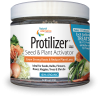It's time for Tulips, Daffodils, and Hyacinth! Well, not exactly but it is time to plant the bulbs of these iconic spring flowers. Here are some tips for successful bulb planting.
Do:
- Plant bulbs in the fall at least 8 weeks before temperatures dip below 48°.
- Plant bulbs in well-drained soil.
- Plant the bulbs 6 – 8" below the surface (trowels usually have the depth marked on the blade).
- Mix the bulbs in with perennials for an interesting look in color and texture.
- Help bulbs establish a thriving root system before winter comes. Fertilize with Natural Alternative® 5-5-5 All Purpose Organic Plant Food. Mix Protilizer® Seed & Plant Activator with water and plant according to the directions below.*
Don't:
- Don't plant bulbs in the shade. They'll grow up spindly with small or no flowers if you do.
- Don't cut the foliage back too early. Wait for it to completely die before cutting it back. The decaying foliage feeds the bulb for next year.
- Don't expect all bulbs to be perennials. Some bloom for just one season. Check the tag.
- Don't limit yourself. Try various colors, striped varieties and textures – like the Parrot Tulip.
If you're feeling ambitious, check out these 18 stunning spring bulbs from Garden Design Magazine.
*The first winter your spring bulbs are planted, it's imperative they send down roots.
- Dig the hole, fill it with the Protilizer® Seed & Plant Activator solution and set the bulb pointy side up.
- Mix one table spoon of Natural Alternative® 5-5-5 All-Purpose Organic plant food with the soil surrounding the hole and back fill. The bulb will absorb the phosphorus (the middle number) to produce flowers the first season.
Phosphorous is a stationery nutrient. It doesn't travel through the soil. That's why it's important to mix the fertilizer with the surrounding soil and backfill.



